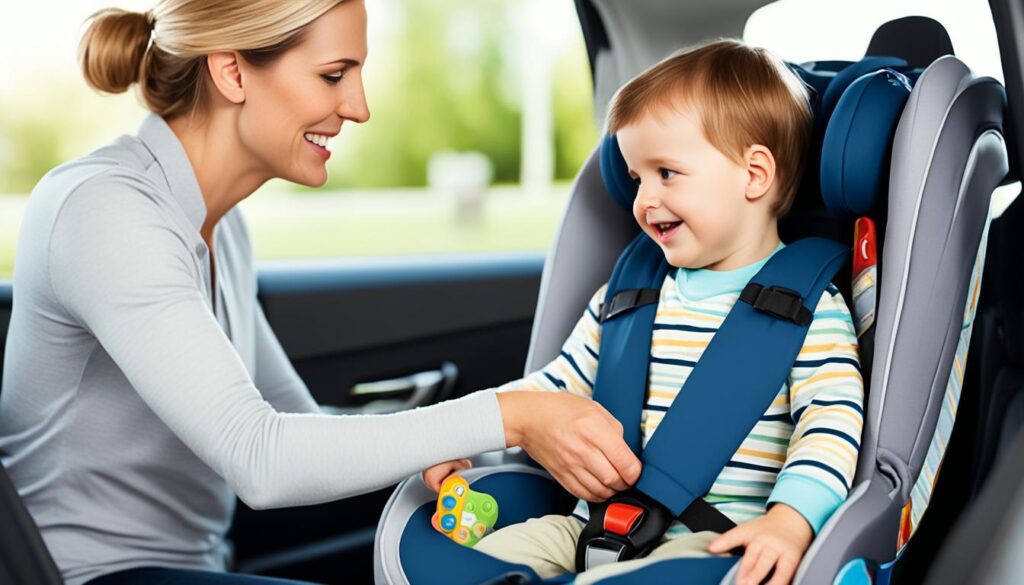Easing the Struggle: Forcing Toddler Into Car Seat
Are you struggling with getting your toddler into the car seat? Don’t worry, you’re not alone. Many parents face battles and resistance when it comes to buckling their little ones in for a car ride. But fear not, there are effective techniques and strategies that can make car seat time easier for both you and your toddler.
In this article, we will discuss the common challenges faced by parents, the importance of communication and confidence, and practical tips for securing your toddler in the car seat without the struggle. By understanding the reasons behind the resistance and implementing successful strategies, you can overcome the car seat battles and create a smoother experience for everyone involved.
Skip To The Following Sections
Key Takeaways:
- Understanding the challenges faced with toddler car seats can help parents approach the situation with empathy.
- Giving yourself extra time and using clear, calm communication can make the car seat experience smoother.
- Building confidence in enforcing car seat rules and embracing flexibility in parenting styles are essential.
- Practical tips, like creating a distraction-free environment and striking win-win compromises, can overcome car seat struggles.
- By implementing these strategies, you can make car seat time easier for both you and your toddler.
Understanding the Challenges
Are you struggling with your toddler’s resistance to car seats? You’re not alone. Many parents face challenges when it comes to getting their toddlers to comply with car seat use. It can be frustrating and exhausting, but understanding the reasons behind their resistance can help you find effective solutions.
Developmental factors play a significant role in car seat compliance. Toddlers are at a stage of asserting their independence and testing boundaries. They may resist being confined in a car seat as they strive for autonomy. Additionally, the discomfort of being restrained and unable to move freely can further contribute to their resistance.
Addressing these challenges requires empathy and patience. By understanding the developmental factors affecting car seat compliance, you can approach the situation with a better understanding of your child’s needs. This understanding can help you find strategies that empower your child while ensuring their safety.
Next, we’ll explore the importance of time and communication in overcoming these challenges. By giving yourself extra time and using effective communication strategies, you can make the car seat experience smoother for both you and your toddler.
Developmental Factors Affecting Car Seat Compliance
Toddlers are at a stage of asserting their independence and may resist being confined in a car seat as they strive for autonomy.
The discomfort of being restrained and unable to move freely can further contribute to their resistance.
Time and Communication: The Key to Success

When it comes to the struggles of forcing a toddler into a car seat, time and effective communication can make a world of difference. Taking the time to create a relaxed and stress-free environment can significantly reduce the pressure and resistance from your child. By avoiding rushing and allowing extra time for the transition, you can help your toddler feel more at ease and cooperative.
But time alone is not enough. Communication is key in getting your toddler to understand and comply with the car seat routine. Clear and calm communication is essential. Use simple and concise language to explain what you need them to do. Toddlers can easily get overwhelmed by complex instructions, so keeping it straightforward is crucial. Take the time to make eye contact and speak with a soothing tone, which can help convey your expectations and establish a positive atmosphere.
Moreover, offering choices and explanations can help empower your toddler and make them feel respected. Instead of dictating what they should do, give them options within the car seat routine. For example, ask them if they would like to buckle themselves or whether they would prefer a particular toy or blanket to bring along. This gives them a sense of autonomy and control, increasing their willingness to cooperate.
In fact, clear and calm communication coupled with giving choices and explanations have numerous benefits. It not only promotes cooperation but also strengthens the parent-child relationship. By involving your toddler in the decision-making process to some extent, you are treating them as an individual and acknowledging their autonomy, which fosters a sense of trust and mutual respect.
“Effective communication is not just about speaking; it’s about creating an atmosphere of understanding and cooperation.”
So, the next time you find yourself caught in a car seat struggle, remember that time and communication can be game-changers. Allow yourself extra time, communicate clearly and calmly, and offer choices and explanations that empower your toddler. Embrace these strategies, and you’ll be on your way to smoother car seat experiences.
Time and Communication Strategies
| Strategies | Benefits |
|---|---|
| Allowing extra time | Reduces pressure and resistance |
| Using clear and calm communication | Helps toddlers understand expectations |
| Giving choices and explanations | Empowers toddlers and promotes cooperation |
| Building trust and mutual respect | Strengthens the parent-child relationship |
Building Confidence and Flexibility

When it comes to enforcing car seat rules, building confidence is crucial. A confident and decisive parenting style can make a significant difference in your toddler’s willingness to comply with car seat regulations. Children respond positively when they sense their parents’ assurance and determination.
One effective way to reinforce positive behavior is through the use of positive reinforcement techniques. Praising your child’s cooperation and compliance with car seat rules can motivate them to willingly follow these guidelines. Consider creating a scrapbook of happy car seat moments, where you can document and celebrate their successful engagements with car seats. This visual representation of their achievements can further encourage their willingness to adhere to car seat rules.
Storytelling is another powerful tool that can be used to introduce the concept of car seats in a fun and engaging manner. You can invent stories that revolve around characters who use car seats and emphasize their importance. By weaving exciting narratives, you can capture your child’s imagination and instill a positive association with car seats.
The power of play should not be underestimated when it comes to establishing a positive attitude towards car seats. Encourage role-play and pretend play activities that involve car seats. This allows your child to familiarize themselves with the purpose and function of a car seat while enjoying interactive playtime.
Flexibility in parenting styles is also essential. Every child is different, and what works for one may not work for another. Embracing flexibility allows you to experiment with various techniques and find what resonates best with your child. As you explore different approaches, always prioritize safety and ensure that you are meeting the necessary car seat requirements.
Overcoming Car Seat Struggles: Tips and Tricks
Are you tired of the daily car seat battles with your toddler? It’s time to make car journeys a peaceful and enjoyable experience for both of you. Here are some practical tips and tricks to help you overcome car seat struggles and ensure success.
Creating a distraction-free environment is essential. Pack some snacks, favorite toys, or soothing music to keep your toddler engaged and calm during car rides. These distractions can help divert their attention from the car seat and make the journey more enjoyable.
Make the car seat as comfortable as possible. Use soft cushions or blankets to provide a cozy and soothing environment. A comfortable seat can go a long way in reducing resistance and making your toddler feel more at ease.
Acknowledge and validate your child’s emotions while enforcing non-negotiable boundaries. Let them know that you understand how they feel and empathize with them. This acknowledgment helps build a sense of understanding and cooperation between you and your toddler.
Striking win-win compromises can make the car seat routine more manageable. Offer choices within the car seat routine, such as allowing them to choose a book or toy to bring along. This gives your toddler a sense of autonomy while still ensuring their safety.
By implementing these practical tips, you can create a distraction-free and soothing car seat environment. You can also acknowledge and validate your child’s emotions while finding win-win compromises. Say goodbye to car seat struggles and hello to smooth and enjoyable car journeys!
FAQ
Why does my toddler resist getting into the car seat?
Toddlers may resist getting into the car seat due to developmental milestones, such as asserting independence and testing boundaries. They may also feel discomfort from being confined.
How can I communicate effectively with my toddler during car seat time?
Clear and calm communication is key. Use simple and concise language to explain expectations. Offering choices and explanations can make toddlers feel empowered and respected.
What role does confidence play in enforcing car seat rules?
Children respond better when parents are confident and decisive. Positive reinforcement and storytelling techniques can help build confidence and motivate children to comply willingly.
What are some practical tips for making car seat time easier?
Creating a distraction-free environment with snacks, toys, or soothing music can keep toddlers calm. Making the car seat comfortable with cushions or blankets can also help. Acknowledging and validating your child’s emotions while setting non-negotiable boundaries fosters understanding and cooperation. Striking win-win compromises, such as offering choices within the car seat routine, can give toddlers a sense of autonomy while ensuring safety.










